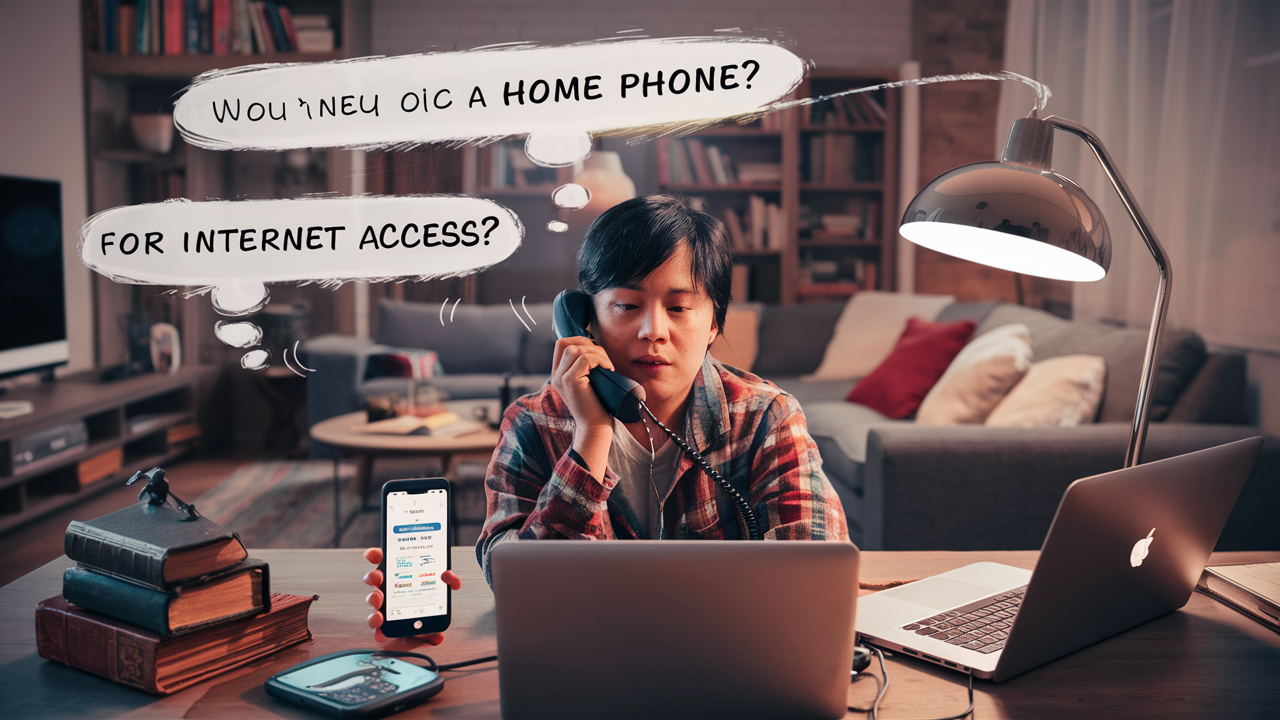Do I need a home phone for internet?

The question of whether a traditional home phone line is necessary for internet access is a common one in our increasingly digital world. This post will directly answer that query, exploring the evolution of internet connectivity and the current landscape of home phone services, offering a clear path to understanding your internet options.
Understanding Internet Connectivity: The Evolution
The journey of internet access has been a rapid and transformative one. From the dial-up modems that screeched and whirred their way to online connectivity, to the lightning-fast fiber optic networks available today, the methods and requirements for getting online have drastically changed. Initially, the existing infrastructure of telephone lines provided the most accessible pathway for early internet adopters. This symbiotic relationship meant that having a landline was often a prerequisite for accessing the nascent digital world. However, as technology has advanced, so too have the ways in which we connect to the internet, leading to a decoupling of these two services for many households. Understanding this evolution is key to answering whether a home phone is still a necessity for internet access in the current technological landscape. The early days of the internet were characterized by limited bandwidth and slow speeds, heavily reliant on the copper wire infrastructure that already existed in homes for voice communication. This fundamental reliance shaped the initial internet service offerings.
Traditional Phone Lines and Internet: The DSL Era
For a significant period, the primary method of delivering broadband internet to homes was through Digital Subscriber Line (DSL) technology. DSL leveraged the existing copper telephone lines to transmit data. This meant that if you wanted DSL internet, you almost invariably needed an active traditional phone line. The phone line acted as the conduit, carrying both voice calls and internet data. This arrangement was beneficial for internet service providers (ISPs) as it minimized the need for new infrastructure development, and for consumers, it offered a relatively affordable and widely available option for high-speed internet compared to the dial-up it replaced. The technology worked by using higher frequencies on the phone line that were not used for voice calls, allowing for simultaneous internet and phone usage. This was a major leap forward, enabling users to browse the web, send emails, and even download files without tying up their phone line. However, DSL had its limitations, primarily its dependence on the distance from the user's home to the telephone company's central office. The further away you were, the slower and less reliable the connection became. Despite these drawbacks, DSL was the dominant form of home broadband for many years, solidifying the link between having a phone line and having internet access in the public consciousness. This era of internet connectivity significantly shaped consumer expectations and ISP business models. The ubiquity of the telephone network made DSL a logical and cost-effective solution for expanding internet access to a broader population.
Is a Phone Line Still Required for Internet in 2025?
As of 2025, the answer to whether you need a home phone line for internet access is a resounding no for the vast majority of households. The technological landscape has shifted dramatically. While DSL internet, which requires a phone line, still exists and is offered by some providers, it is no longer the primary or most advanced form of internet connectivity. Modern internet technologies have largely decoupled the need for a traditional landline. Fiber-optic internet, cable internet, and various wireless solutions do not require a phone line to function. In fact, many ISPs now offer internet-only plans, allowing customers to subscribe to high-speed internet without the added cost or necessity of a traditional phone service. This separation is a direct result of advancements in networking infrastructure and the increasing demand for faster and more reliable internet speeds. Consumers have more choices than ever before, and the dependency on the old telephone network has significantly diminished. The market has responded to consumer preferences for flexibility and cost-effectiveness, leading to a diversification of internet service options. For those who still rely on DSL, it's often because it's the only available option in their specific geographic location, or perhaps due to legacy reasons or bundled service preferences. However, for anyone looking to establish new internet service or upgrade their existing connection, the absence of a traditional phone line is rarely a barrier. The industry has moved beyond this limitation, embracing more advanced and independent delivery methods. This transition is a testament to the rapid pace of technological innovation and the evolving demands of a connected society.
Alternatives to Traditional Phone Lines for Internet
The good news for consumers in 2025 is that the internet is no longer tethered to the traditional phone line. A diverse array of technologies and service providers now offer robust internet connectivity without the need for a landline. These alternatives cater to different needs, budgets, and geographical locations, providing flexibility and often superior performance. Let's explore the most prevalent options available today.
Cable Internet
Cable internet is one of the most widely available and popular broadband options in many urban and suburban areas. It utilizes the same coaxial cable network that delivers cable television. This infrastructure allows for high-speed data transmission, often offering speeds that are significantly faster than DSL. Cable internet is a shared network, meaning that the bandwidth is shared among users in a particular neighborhood. While this can sometimes lead to slower speeds during peak usage hours, for most users, the performance is more than adequate for streaming, gaming, and general browsing. Cable internet does not require a phone line, making it a direct alternative for those looking to cut the cord on their landline. Installation typically involves a technician connecting a modem to the cable outlet in your home.
Pros of Cable Internet:
- Widely available in many populated areas.
- Offers competitive speeds, often exceeding DSL.
- No phone line required.
- Relatively affordable pricing for good speeds.
Cons of Cable Internet:
- Speeds can fluctuate based on neighborhood usage.
- Shared bandwidth can lead to congestion.
- Not as widely available in very rural areas.
Fiber-Optic Internet
Fiber-optic internet is considered the gold standard for broadband connectivity. It uses thin strands of glass or plastic to transmit data as pulses of light. This technology offers incredibly high speeds, symmetrical upload and download rates, and exceptional reliability. Fiber optic cables are immune to electromagnetic interference, meaning they are not affected by weather or other external factors that can impact copper-based lines. While fiber optic networks are still being expanded, their availability is growing rapidly, especially in new developments and urban centers. If fiber is available in your area, it is often the best choice for performance and future-proofing your home's internet connection. Crucially, fiber optic internet requires no phone line. Installation involves running fiber optic cables directly to your home.
Pros of Fiber-Optic Internet:
- Extremely high speeds, often in the gigabit range.
- Symmetrical upload and download speeds.
- Highly reliable and stable connection.
- Future-proof technology.
- No phone line required.
Cons of Fiber-Optic Internet:
- Availability is still limited in many areas.
- Can be more expensive than other options.
- Installation can be more complex.
Wireless Internet Options
Wireless internet solutions have become increasingly sophisticated, offering viable alternatives for internet access without physical cables. These technologies leverage radio waves to transmit data.
Fixed Wireless Internet
Fixed wireless internet uses a base station (often on a tower) to transmit signals to a receiver installed at your home. This is a popular option in rural or semi-rural areas where laying traditional cable or fiber is cost-prohibitive. It requires a clear line of sight between your home and the base station. Speeds can vary significantly depending on the provider, equipment, and distance. Fixed wireless does not require a phone line.
Pros of Fixed Wireless:
- Good option for rural areas where wired broadband is scarce.
- Can offer competitive speeds.
- No phone line required.
Cons of Fixed Wireless:
- Requires a clear line of sight.
- Performance can be affected by weather and obstructions.
- Speeds may not match cable or fiber.
Satellite Internet
Satellite internet provides access to the internet via a satellite dish installed at your home. It is a solution for extremely remote locations where no other terrestrial broadband options are available. However, satellite internet is known for its higher latency (delay), which can impact real-time applications like online gaming or video conferencing. Speeds can also be slower and more variable compared to other broadband types, and it often comes with data caps. Satellite internet does not require a phone line.
Pros of Satellite Internet:
- Available virtually anywhere with a clear view of the sky.
- No phone line required.
Cons of Satellite Internet:
- High latency can affect real-time applications.
- Speeds can be slower and less reliable.
- Often comes with strict data caps.
- Can be affected by weather conditions.
5G Home Internet
A significant development in recent years is 5G home internet. This service uses the latest generation of cellular technology to provide broadband internet directly to your home. Providers offer a small cell or router that connects to the nearest 5G tower. For many users, 5G home internet can offer speeds comparable to or even exceeding cable, with the convenience of a wireless setup. It's a strong contender for those seeking a fast, reliable, and phone-line-free internet connection. Availability is expanding rapidly in urban and suburban areas.
Pros of 5G Home Internet:
- Potentially very high speeds, rivaling fiber.
- Easy setup, often plug-and-play.
- No phone line required.
- Flexible and portable in some cases.
- Growing availability.
Cons of 5G Home Internet:
- Availability is still limited and expanding.
- Performance can vary based on signal strength and network congestion.
- May have data caps or speed throttling after certain usage.
VoIP and Internet Phone Services: A Modern Approach
While a traditional landline phone is no longer necessary for internet, many people still want or need a home phone service. This is where Voice over Internet Protocol (VoIP) comes in. VoIP technology transmits voice calls over the internet, rather than through traditional circuit-switched telephone lines. This offers a modern, flexible, and often more cost-effective way to have a home phone.
VoIP services can be provided by dedicated VoIP providers or bundled with internet service by ISPs. You typically connect a VoIP adapter or use a VoIP-enabled phone that plugs into your router. The key advantage is that it uses your existing internet connection, so you don't need a separate phone line. Many VoIP plans offer unlimited local and long-distance calling, international calling options, and features like voicemail-to-email, call forwarding, and caller ID, often at a lower price point than traditional landlines.
For those who want both internet and a phone, a VoIP service is the modern solution that complements, rather than competes with, their internet access. It leverages the same internet infrastructure that powers their online activities. This integration simplifies home telecommunications and aligns with the digital-first approach of most households.
Key benefits of VoIP:
- Cost Savings: Often significantly cheaper than traditional landlines.
- Enhanced Features: Advanced features not typically found in basic landlines.
- Flexibility: Can often be used with various devices and locations.
- No Phone Line Required: Operates solely over your internet connection.
- Bundling Opportunities: Frequently bundled with internet services for added value.
When considering your home phone needs, it's important to distinguish between the requirement for a phone line for internet access (which is largely obsolete) and the desire for a phone service itself. VoIP effectively bridges this gap, offering a contemporary solution for voice communication that relies on the very internet that has replaced the need for a traditional phone line for connectivity.
Factors to Consider When Choosing Internet Service
With a plethora of internet service options available in 2025, each with its own set of pros and cons, making the right choice can seem daunting. The decision should be based on a careful assessment of your individual needs and circumstances. Here are the key factors to consider to ensure you select the best internet service for your home, without needing a traditional phone line.
Availability in Your Area
This is the most critical first step. Not all internet technologies are available in every location. Fiber optic internet, for example, is still being rolled out and is more common in densely populated areas. Cable internet is widespread but may not reach every rural home. Fixed wireless and satellite are often the only options for those in very remote regions. 5G home internet availability is growing but is also concentrated in certain areas. Your first action should be to check with local ISPs and use online tools to see which services are actually offered at your specific address. A quick search on provider websites or using comparison tools can reveal your options.
Steps to check availability:
- Visit the websites of major ISPs (e.g., Verizon, AT&T, Spectrum, Xfinity, T-Mobile, Starlink).
- Enter your full address to see available plans and technologies.
- Utilize third-party comparison websites that aggregate ISP offerings by location.
Speed and Performance Needs
Consider how you and your household use the internet.
- Basic Browsing and Email: Lower speeds (e.g., 25-50 Mbps) might suffice.
- Streaming HD Video (Netflix, YouTube): Recommended speeds of 50-100 Mbps or higher.
- Multiple Users and Devices: If several people are online simultaneously, streaming, gaming, or working from home, you'll need higher speeds (100-300 Mbps or more).
- Online Gaming and Large Downloads: High speeds and low latency are crucial, making fiber or high-tier cable/5G ideal.
- Working from Home (Video Conferencing, Large File Transfers): Requires consistent, reliable speeds, often with good upload capabilities.
Many providers offer tiered speed packages. It's important to choose a plan that meets your current needs without overpaying for excessive speed you won't utilize. However, it's also wise to consider future needs, as internet usage tends to increase over time.
Cost and Budget
Internet service costs vary significantly based on the technology, speed, and provider. Fiber optic and high-speed cable plans can be more expensive, while DSL or basic wireless plans might be cheaper. Satellite internet often has a higher monthly cost with data caps. 5G home internet is often positioned as a more affordable alternative to traditional cable or fiber.
When evaluating cost, look beyond the advertised monthly price. Consider:
- Installation Fees: Some providers charge a one-time fee for setup.
- Equipment Rental Fees: Modems and routers may be rented monthly. Purchasing your own equipment can sometimes save money in the long run.
- Contract Length: Many plans require a 12 or 24-month contract. Early termination fees can apply if you break the contract.
- Promotional Pricing: Be aware of introductory offers that may increase after a certain period.
Compare the total cost of ownership over the contract term to get a true picture of affordability.
Bundle Deals and Package Options
Many ISPs offer bundle deals that combine internet, TV, and sometimes phone (VoIP) services. Bundling can sometimes lead to cost savings compared to subscribing to each service individually. However, it's essential to assess whether you actually need all the services included in the bundle. If you only need internet, an internet-only plan might be more cost-effective. If you are considering a VoIP service, check if your internet provider offers a bundled package that includes it.
When considering bundles:
- Determine if you will use all bundled services.
- Compare the bundled price against the cost of individual services from different providers.
- Read the fine print for any hidden fees or limitations.
Reliability and Customer Support
Speed and price are important, but so is reliability. An internet connection that is constantly dropping or experiencing outages can be incredibly frustrating. Reviews and independent testing can provide insights into a provider's reliability.
Customer support is another crucial factor. When you encounter issues, you want to be able to reach a helpful and responsive support team. Look for providers with good customer service ratings, multiple support channels (phone, chat, email), and reasonable wait times. Local providers or those with a strong reputation for support can be a good indicator.
Assessing reliability and support:
- Read online reviews and consumer reports.
- Ask friends and neighbors about their experiences.
- Check provider websites for uptime guarantees or service level agreements (SLAs).
- Consider the availability of local support technicians.
By carefully evaluating these factors, you can make an informed decision about which internet service best suits your needs and budget, all without the necessity of a traditional home phone line.
The Future of Home Telephony and Internet
The trajectory of home telecommunications clearly points towards further integration and independence from traditional infrastructure. The future of home telephony is inextricably linked with the internet. We are already well into the era where Voice over Internet Protocol (VoIP) is the dominant form of voice communication for businesses and increasingly for homes. This trend is expected to accelerate.
For internet access, the push is towards faster, more ubiquitous, and more reliable connections. Fiber optic networks will continue to expand, offering unparalleled speeds and capacity. 5G technology is not just for mobile devices; 5G home internet is poised to become a major player, offering a compelling wireless alternative to wired broadband in many areas. Innovations in satellite technology, like low-Earth orbit (LEO) constellations, are also improving speeds and reducing latency for satellite internet, making it a more viable option for remote locations.
The concept of a "phone line" as a distinct utility required for other services is rapidly becoming obsolete. Instead, internet connectivity will be the foundational utility upon which all other communication and entertainment services are built. This includes voice calls, video conferencing, smart home devices, and immersive digital experiences. The distinction between "internet service" and "phone service" will continue to blur, with most voice communication being delivered as an application over the internet.
We can anticipate even more seamless integration of communication tools into our daily lives, powered by robust internet infrastructure. The need for a separate, dedicated phone line for basic connectivity is a relic of the past, replaced by a more flexible, powerful, and interconnected digital ecosystem. The future is about leveraging the internet for all your communication needs, from browsing and streaming to calling and connecting with loved ones.
Conclusion: Making the Right Choice for Your Home
In conclusion, the question "Do I need a home phone for internet?" has a clear and definitive answer for most consumers in 2025: no. The evolution of technology has liberated internet access from the confines of the traditional telephone network. While DSL, which historically required a phone line, still exists, it has been largely surpassed by superior alternatives like cable, fiber optic, and advanced wireless solutions (including 5G home internet). These modern technologies offer faster speeds, greater reliability, and the flexibility to choose internet-only plans.
If you still desire a home phone service, Voice over Internet Protocol (VoIP) provides a cost-effective and feature-rich solution that operates over your internet connection, eliminating the need for a separate landline. When selecting your internet service, prioritize checking availability in your area, assessing your speed requirements, comparing costs including all fees, considering bundle options, and evaluating reliability and customer support. By focusing on these factors, you can confidently choose an internet service that meets your household's needs without the outdated requirement of a traditional home phone line. Embrace the freedom and flexibility of modern internet connectivity.




